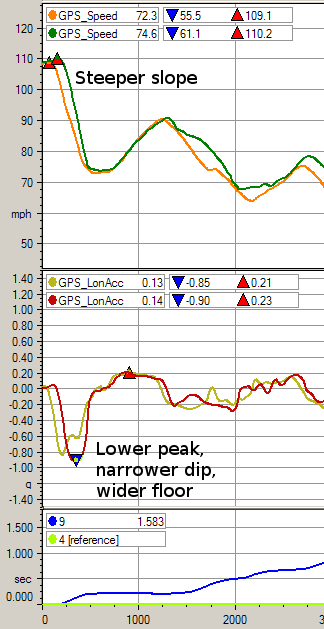Comparing To Yourself
Published: July 12, 2014
You can get a lot of value from data acquisition by examining your own data. Comparing your data against that of other drivers can show you more directly what the car is capable of, but if you have nobody to compare data with you can still make most of the same improvements in your driving.
Peaks
The basic principle behind looking for peaks is that if you did something once, you should be able to do it again. The goal, then, is to:
- Identify the peaks;
- Figure out how the peaks have been achieved; and
- Consistently executing inputs that resulted in the peaks.
For example, suppose normally you brake at the 3 marker, but one lap you braked at 2.75 instead. If you were able to still slow down enough to make the corner, it stands to reason that you should be braking at 2.75 instead of 3.
Looking for peaks exploits the fact that we are not perfectly consistent when we drive. Sometimes we apply an input a bit earlier, sometimes a bit later. Once a session is over we look through the data to see which deviations from the status quo are beneficient, and try to make those unusual inputs into the new status quo.
When examining data, peaks look something like this:

Here, the green trace car is braking later and harder than the orange trace car, arriving at the same speed by the turn in point but going faster throughout the braking zone. Green speed trace has a higher slope than the orange speed trace which corresponds to greater forward Gs being applied. The second graph is forward Gs; the red trace (corresponding to the green trace on the speed graph) has a lower peak, narrower dip overall but wider floor of the dip - the car brakes harder but for less time.
With the peaks and the reasons for them identified, the next step is hitting the peaks consistently. Consistency here comes in two dimensions: temporal (you should be able to drive the same way in each corner every lap of a session) and spatial (you should be able to drive similar corners similarly).
Temporal consistency is the easier of the two. Novice drivers normally increase their pace throughout each session, with the fastest lap occurring about 15-20 minutes into the session. Advanced drivers on the other hand get to their peak pace very early in the session - often within 3-5 laps. What enables advanced drivers to do this? The biggest factors I would say are reference points and confidence.
Spatial consistency is more applicable to more advanced drivers who can accurately analyze corners. Suppose a car was driving on a square course; each turn should be taken exactly the same. If a driver brakes harder in one of the corners but less hard in the other corners, the driver simply leaves unused grip in three of the corners.
The tricky aspect of spatial consistency is recognizing which corners are similar, and which are not. Not all cocrners demand threshold braking; in some corners, performing threshold braking is counterproductive.
Variance
At amateur level it is rare for a driver to drive two laps exactly the same. There will be small variations in speed, braking points, throttle application points, the line, etc.
Reducing these variations makes you faster, if you are converging on the absolute grip limit. For example, suppose you on lap 5 you brake for turn 1 from 100 mph and on lap 6 you brake for turn 1 from 96 mph. Somewhere you lost 4 mph which cost you lap time. If you reduced the variance to 2 mph, thus raising your speed from 96 mph to 98 mph, you would be lap the track in less time.
Variation by itself is not actionable - you need to figure out the cause for variance and address the cause. However, variance is useful for tracking your progress: as you get better, the variance will reduce.
If you are a generally experienced driver learning a new track, variance is a good indicator of how well you have learned the track: if your variance is close to whatever is "normal" for you, you are mostly past the learning and are in the driving phase. If your variance is higher than "normal", you are still trying to figure the track out.
Progression
As you accumulate track time, you should be becoming a better driver, and therefore a faster driver. If you use the same data acquisition system and you drive the same car, your lap times should be decreasing with time. Not only lap times overall though - your segment times should be decreasing as well - you should be getting faster in every turn!
Looking at segment times across events is a good way to determine if you are unintentionally proceeding on a wrong path. For example, if you become more aggressive you might slide the car more, but at some point sliding will cost you lap time. If you are driving more aggressively but slower this is a sign that your aggression is developing faster than your driver skills - time to relax and work on smoothness.
 Visit our
Visit our